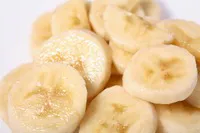Many studies have demonstrated the efficacy of calcium compounds application by dipping in maintaining the firmness of fresh-cut apple, pear, banana and strawberry. However, the presence of residual calcium on cut surface may change the characteristic flavor of the product that can be detected as bitterness increase by the consumer. The bitterness and salty taste caused by calcium compounds can be avoided by combining the calcium with lactate, gluconate, glycerolphosphate, etc.
Other studies have demonstrated that the edible coatings applied on the whole or fresh-cut produce act as barrier to water loss and oxygen access. The polysaccharides edible coatings, such as carrageenan, maltodextrin, methylcellulose, carboxymethyl cellulose, pectin, alginate, chitosan, have been successfully used to coat fresh-cut fruits. In addition, the functional, nutritional, sensory and mechanical properties of the coating can be improved by using additives that enhance the flavor, aroma, firmness, and preserve the nutritional value of the product.
 A Portuguese research group (Bico et al., 2010) has conducted a study on fresh-cut banana Musa acuminata Colla, cv. Cavendish). The aim of the work was to preserve the color and the firmness of fresh-cut banana slices, stored at 5°C for five days, testing two dip solutions, 5 edible coatings and assessing the combined action of chemical dip with edible coating.
A Portuguese research group (Bico et al., 2010) has conducted a study on fresh-cut banana Musa acuminata Colla, cv. Cavendish). The aim of the work was to preserve the color and the firmness of fresh-cut banana slices, stored at 5°C for five days, testing two dip solutions, 5 edible coatings and assessing the combined action of chemical dip with edible coating.Dip solutions differing in calcium compound and the edible coatings evaluated in the study are following listed.
Dip solutions:
- solution with 1% (w/v) calcium chloride, 0.5% (w/v) ascorbic acid and 0.75% (w/v) cysteine;
- Solution with 2% (w/v) calcium lactate, 0.5% (w/v) ascorbic acid and 0.75% (w/v) cysteine.
- alginate;
- carboxymethil cellulose (CMC);
- carrageenan;
- chitosan;
- pectin.
After three days of storage, the greatest loss of firmness was detected in samples not treated (control, 47%), followed by the samples treated with only edible coating (about 40%) and by the samples treated with only the dip solution with calcium chloride (32%). The lowest firmness loss was detected in the samples treated with calcium chloride dip solution combined with the edible coating and it ranged from 15 to 24% according to the edible coating used.
After five days of storage, the carrageenan, combined with calcium chloride dip solution, resulted the most effective edible coating in maintaining the color and firmness of banana slices, while the pectin resulted the least effective.
In this work, the authors have highlighted the importance of both dipping operation and calcium chloride application by dipping in the fresh-cut processing of banana to guarantee a five-days shelf-life.
Original study. Bico S.L.S, Raposo M.F. J, Morais R.M.S., Morais A.M.M., "Chemical dips and edible coatings to retard softening and browning of fresh-cut banana", 2010, International Journal Postharvest Technology and Innovation, Issue N. 2 (1), pagg. 13-24. Further info: http://web.esb.ucp.pt/docs/IJPTIBanana.pdf
